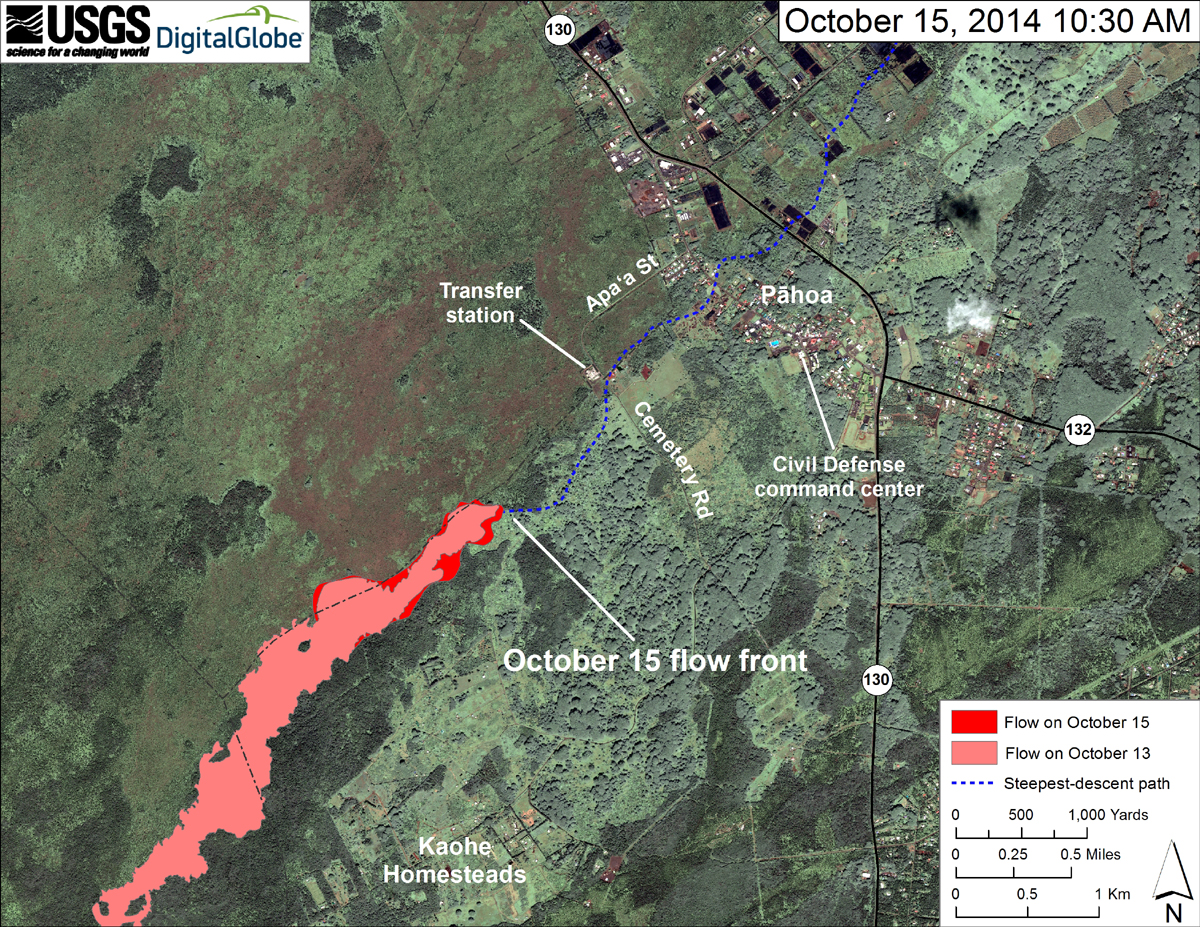(ABOVE PHOTO) The lava flow front advancement has slowed, but active breakouts persist near the front, as this October 15 USGS Hawaiian Volcano Observatory photo shows.
(ABOVE VIDEO) USGS Hawaiian Volcano Observatory geologist Tim Orr details the latest lava observations during a media conference held on Wednesday.
NEWS BRIEF
- The June 27th lava flow remains active, although it is advancing slowly. The flow front has crawled 55 yards since October 13.
- USGS Hawaiian Volcano Observatory geologist Tim Orr answered some questions about the latest slow down during a media conference held on Wednesday (video above).
PRIMARY SOURCES

Volcano: Kilauea (VNUM #332010)
Current Volcano Alert Level: WARNING
Current Aviation Color Code: ORANGE
Issued: Wednesday, October 15, 2014, 5:28 PM HST (20141016/0328Z)
Source: Hawaiian Volcano Observatory
Notice Number: 2014/H17
Location: N 19 deg 25 min W 155 deg 17 min
Elevation: 4091 ft (1247 m)
Area: HI Hawaii and Pacific OceanVolcanic Activity Summary: The June 27th flow remains active, with the flow front having advanced downslope about 50 m (55 yd) since October 13. Breakouts as far as 1.8 km (1.1 mi) upslope widened the flow by as much as 100 m (109 yd) in the past 2 days. The flow front remains about 1.4 km (0.9 mi) upslope from Apa`a St. along the steepest descent path and 1.1 km (0.7 mi) upslope from Apa`a St. along a straight line. Because the flow has slowed in the past 2 days to about 25 m/day (27 yd), we do not offer a future projection of the flow’s advance. Our next overflight is scheduled for Friday morning, but Tropical Storm Ana may ground the flight.
Pāhoa town is in the Puna District of the County of Hawai`i.
Recent Observations:
[Lava flow] The June 27th lava flow has advanced at an average rate of 49 m/day (54 yd) since October 8. The leading edge is now about 1.1 km (0.7 mi) straight-line distance from Apa`a St.Hazard Analysis:
[Lava flow] The June 27th lava flow from the Pu‘u ‘Ō‘ō vent is active, and lava is being supplied to the flow front, which is slowly advancing downslope toward Pāhoa.Remarks: The Pu‘u ‘Ō‘ō vent in the East Rift Zone of Kīlauea Volcano began erupting on January 3, 1983, and has continued erupting for more than 31 years, with the majority of lava flows advancing to the south. Over the past two years, lava flows have issued from the vent toward the northeast. The June 27th flow is the most recent of these flows and the first to threaten a residential area since 2010-2011. On June 27, 2014, new vents opened on the northeast flank of the Pu‘u ‘Ō‘ō cone and fed a narrow lava flow to the east-northeast. On August 18, the flow entered a ground crack, traveled underground for several days, then resurfaced to form a small lava pad. This sequence was repeated three more times over the following days with lava entering and filling other cracks before reappearing at the surface, in two of the cases farther downslope. Lava emerged from the last crack on September 6, forming a surface flow that initially moved to the north, then to the northeast, at a rate of 400 m/day (437 yd). The flow slowed thereafter and, between September 12 and 19, the rate of advancement varied, averaging 225 m/day (246 yd). The flow front stalled by September 22, but new breakouts upslope overtook the stalled front on September 29. During the past 2 weeks, advance rates of the flow front have varied between about 120 m/day (131 yd) and 25 m/day (27 yd). USGS Hawaiian Volcano Observatory on Oct. 12

Satellite image of area around flow front, posted by USGS Hawaiian Volcano Observatory on October 15th.
ABOVE: This map uses a satellite image acquired in March 2014 (provided by Digital Globe) as a base to show the area around the front of the June 27th lava flow. The area of the flow on October 13, 2014, at 9:30 AM is shown in pink, while widening and advancement of the flow as mapped on October 15 at 10:30 AM is shown in red. The flow front advanced about 50 m (55 yd) since our October 13, 2014, overflight. The flow front is still about 1.1 km (0.7 mi) upslope from the closest point along Apaʻa Street (Cemetery Road), as measured in a straight line, and about 1.3 km (0.8 mi) measured along the path of steepest-descent that the flow is currently following.
A 10-day flow projection is not included because of the very low flow advance rate over the past two days. The flow, however, could speed up again at any time (or slow down even further); it could stall, and a new active flow front could start again farther upslope; or the flow could stop altogether.
The dotted blue line shows the steepest-descent path, calculated from a 1983 digital elevation model (DEM; for calculation details, see http://pubs.usgs.gov/of/2007/1264/), that the flow is projected to follow. Steepest-descent path analysis is based on the assumption that the DEM perfectly represents the earth’s surface. DEMs, however, are not perfect, so the dotted blue line can be used to infer only an approximate flow path. (SOURCE: USGS HVO)

by Big Island Video News8:59 pm
on at
STORY SUMMARY
USGS scientist Tim Orr answeres questions about the latest lava activity during a Wednesday media conference